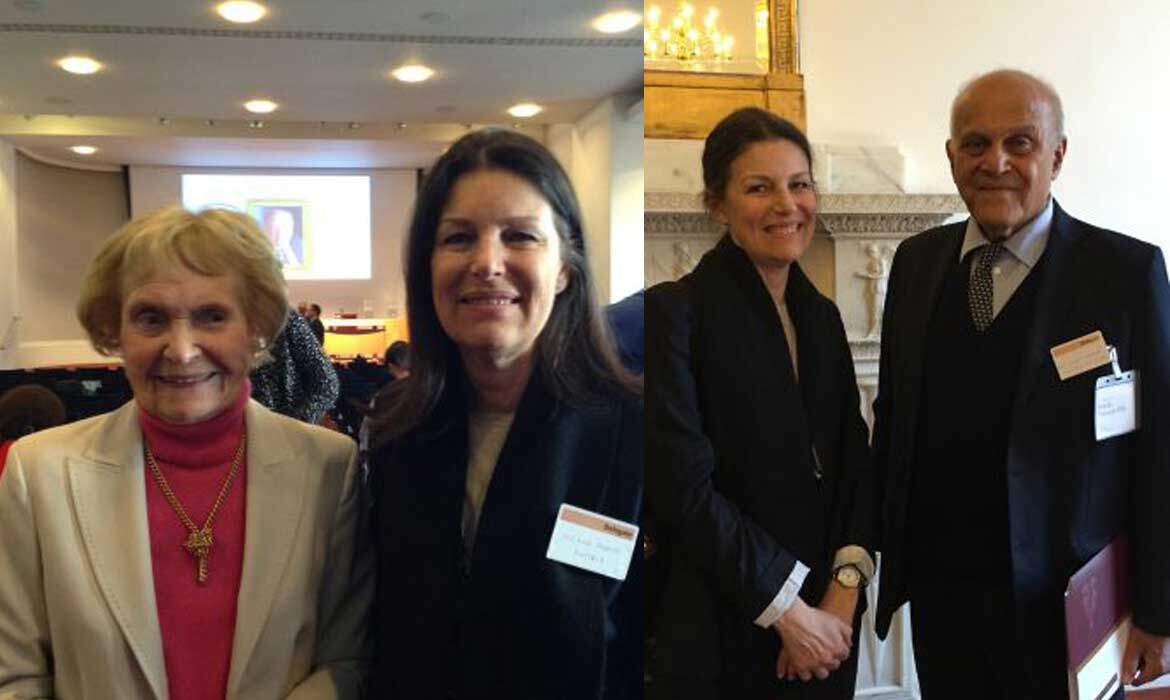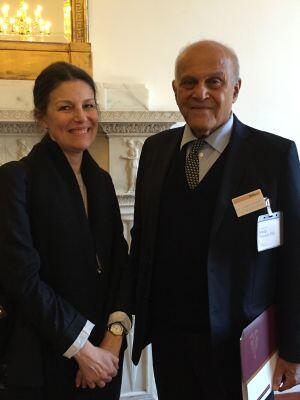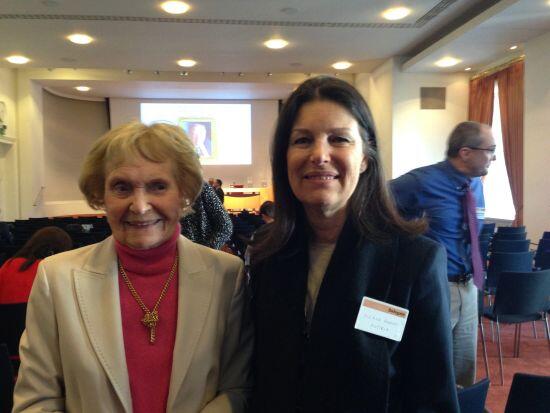Sir John VANE Annual Symposium on Prostacyclin Science and Pulmonary Vascular Disease


Pisana Ferrari with Sir Magdi Habib Yacoub, world renowned cardiothoracic surgeon
The Tenth John Vane Memorial Symposium on Prostacyclin Science and Pulmonary Vascular Disease was held in London on March 6 and 7. This annual event is held in memory of Sir John Vane, who shared the Nobel Prize in medicine with Salvator Moncada in 1982 for his work on prostaglandins. Together with colleagues at Wellcome Sir John Vane also discovered prostacyclin, a vasodilator prostaglandin that helps prevent blood clots by reducing the stickiness of platelets, which was to be used in later years in the treatment of pulmonary arterial hypertension.
It was a great privilege to be invited to attend this very interesting symposium which provided the opportunity to hear the latest developments in the area of pulmonary hypertension from some of the top researchers and clinicians in the world. The agenda covered a variety of topics, with sessions on basic science and others on clinical practice and treatments. What follows is a brief summary of some of the presentations.
A new oral prostacyclin receptor agonist
Prof. Olivier Sitbon, from the Université Paris Sud, France, spoke about selixipag (the first in-class oral non-prostanoid prostacyclin receptor agonist) and the clinical trials which have been held up to now, including a Phase I trial on healthy volunteers, the proof of concept Phase II study and the Phase III GRIPHON clinical trial, the preliminary results of which are now available (the full data will be released at the American College of Cardiology’s Annual Congress in San Diego, USA on 15 March 2015). The Phase I trial showed that the half life of the drug supported twice a day dosage, that there were no serious side effects or food interactions, that there was no accumulation with multiple doses and that multiple doses also did not affect warfarin. The proof of concept Phase II trial demonstrated very significant changes in hemodynamic parameters, in particular a decrease by 30% in pulmonary vascular resistance, which was the main endpoint. GRIPHON was a large, long term, double blind, randomized controlled morbidity/mortality clinical trial. It was an event driven trial, its primary endpoint being time to the first morbidity/mortality event. All events were adjudicated by an independent blinded clinical events committee. The trial involved 1.156 patients over a period of 4.3 years; 80% of the patients were on background therapy (ERA or PDE-5 inhibitors). The most significant result of the study was a drop in risk of morbidity or mortality by 39%. The findings were consistent across the various sub-groups (different etiologies, naive or treated patients). Adverse events were similar to those of prostanoids. The experience with prostanoids and these new clinical trials show that:
- targeting the prostacycling pathway is of primary importance
- prostacyclin analogues have shown good efficacy but have important limitations in the ways of administration
- selixipag is the first drug in this class allowing a twice a day administration
- selixipag has shown to improve hemodynamics and reduce morbidity/mortality.
Sub-cutaneous treprostinil in Germany
Prof. Ekkehard Grünig, from the Heidelberg University in Germany, is the principal investigator of the RAPID study, which is a 16 week, open label, multicenter clinical trial investigating rapid dose titration of sc Remodulin. The final data are not public yet but preliminary results are available. They suggest that a rapid dose increase (up to 30 ng/kg/min) of subcutaneous Remodulin therapy in PAH patients that are treatment naive, or receiving approved mono or dual therapy is safe and better tolerable. Furthermore, the study results suggest that this therapy improves the pulmonary hemodynamic as PVR and cardiac function measured by right heart catheterization and further clinical parameters as the 6 minute walking distance, functional class and Borg dyspnea score. Prof. Gruenig said that Remodulin has now become a more feasible option for patients in Germany, where intra-venous epoprostenol is more difficult due to the lack of medical support by the distributer (no helplines, no emergency support). The side effects of subcutaneous Remodulin could be overcome with implanted pumps. He presented the case study of a young female patient who, after some time on monotherapy with bosentan had to be put on double combination therapy with sildenafil because of disease progression. Further deterioration led to the decision, a couple of years later, to prescribe sub-cutaneous treprostinil and a few months later implantation of a subcutaneous pump system. The young patient is now doing very well, with a net improvement in hemodynamics and symptoms. In reply to a question of the audience, Prof. Gruenig spoke of the rehabilitation and education program for PAH patients at the Heidelberg University, which he has been running for a number of years. He said that a for PH-patients specialized program can further improve the patients, as demonstrated by dedicated studies. We as a patient association believe that this specialized PH-rehab program including both PH and rehabilitation specialists who are experienced in exercise training of severely compromised patient has a very important role to play alongside medical treatment and would very much welcome to see its use become more widespread.
Oral versus parenteral prostacyclin?
Olivier Sitbon’s presentation was followed by a debate between Irene Lang, from the Medical University of Vienna, and Jim White, from the Rochester Medical Center in the USA, on whether oral prostacyclins could replace parenteral therapy. In this very lively discussion Jim White spoke in favour and Irene Lang against. White started first by saying that it was almost a “mission impossible” to prove that the oldest, most established treatment for of PAH could be replaced! However he pointed out that ultimately it came down to a question of dosage. There is a growing body of evidence to show that Flolan and Remodulin are more effective at higher doses. These higher doses are very difficult to achieve with parenteral therapy. White and his colleagues at Rochester have recently completed a six months study successfully transitioning 25 patients with sub-cutaneous prostacyclin to oral treprostinil. The patients were transitioned in the course of a five-day stay in hospital. The results were good and identical to the patients who had remained on parenteral therapy. All patients in the study who transitioned were happy with the change (the trade off being more nausea and headache). White added that one has to also take into account the patient’s quality of life. Parenteral therapy creates a permanent disruption in four key areas: shower, swimming, sleeping, and sex… Prof. Irene Lang argued that despite the fact that pumps are “not friendly” the problem of titration of oral prostanoids is far from easy to manage and she quoted the issues with Beraprost when it was introduced many years ago (it is not longer available in Europe). She said there were lessons to be learned from this case for the industry as well as from inhaled prostanoids, who have shown that benefits are mostly only around inhalation time and not sustained over time. The problem with the switch is also that it is very different if you do it on naive patients or patients who are already on sub-cutaneous. Prof. Lang concluded by saying that current data do not support replacement of parenteral prostacyclins with oral, and more studies are necessary. PH patients would certainly welcome a less invasive means of administration of prostanoids but only if the benefits are substantiated with strong data. We very much look forward to hearing about the final data on Griphon after the ACC Congress in March 2015.
High dose epoprostenol in IPAH patients in Japan
There was one other very interesting presentation about prostanoids by Dr. Hiromi Matsubara of the Okayama Medical Center in Japan. Dr Matsubara and his team have been treating a number of idiopathic hereditary PAH patients with very high doses of intravenous epoprostenol (up to 60-80ng/kg/min). The results have been very good, with survival rates at 5 years similar to those of “responders” to the acute vaso-reactive test at RHC. The experience at the Okayama center has shown that high doses of epoprostenol with a rapid increase of dose in the first two years can lead to significant decreases in mean pulmonary arterial pressure (mPAP) in a certain percentage of patients, the trade off being significant but tolerable side effects. According to Dr. Matsubara and his team of researchers long term survival can only be achieved with a sufficient decrease in mPAP.
Right heart catheter for PAH diagnosis, yes or no?
During the symposium there was another very interesting debate about right heart catheterisation (RHC) and whether it is really essential to perform this in order to establish a correct diagnosis of pulmonary hypertension, with Prof. Stephan Rosenkranz, from the University of Cologne, arguing for and Prof. Robert Naeije, from the ULB University in Belgium, against. Prof. Rosenkranz stated that the RHC has been considered essential in the diagnosis of PAH for a long time and this has become an established standard of care, as demonstrated by the PH clinical guidelines. Data support the need for an invasive exam to confirm the disease. It is not possible to rely only on echo as this can be inaccurate and there is a high of false positives. According to Prof. Naeije the RHC is probably not as accurate as one thinks and is potentially harmful. Studies have shown there are increased risks of pulmonary hemorrhage and arrythmias and deaths are rare but happen as well. Additionally one can speak of a “knowledge deficit” in the sense that interpretations of parameters in RHC can vary widely, even in expert centres (from 43% to 67%). There is therefore a risk of misclassification and of misdiagnosis. The extensive use of RHC and the ignorance of non invasive imaging has also hindered progress in innovation and research on alternative ways to measure the vital parameters. The pulmonary embolism community has “scores “ for diagnostic purposes which are entirely clinical; we could take this as an example, suggests Naeije. Alternative measures could include non-invasive algorithms such as the diagnostic decision tree suggested by Dr. Diana Bonderman from the University of Vienna in the CART project and the early detection diagnostic algorithm tested by Dr. Gerald Coghlan of the Royal Free Hospital in London in the DETECT study. These studies are based on different indicators and non-invasive imaging and have proven to be very reliable. Prof. Naeije said that some groups have already started to use echo in a more “clever” way, eg. Alexander Opotowsky and Michele d’Alto who hypothesize that a combination of several variables associated with PH (eg. heart chamber size, atrial pressure, etc) analyzed during echo can have very high predictive value and provide results comparable to RHC. As patient representatives we obviously welcome warmly any measures which would limit the use of RHC, an extemely stressful procedure which has a strong psychological impact on patients and can be potentially harmful, in particular in children, on account of the need for general anesthesia.
Riociguat for PAH and CTEPH and other forms of PH
Prof, Ardeshir Ghofrani from the Giessen center in Germany spoke about the clinical trials leading up to the approval of riociguat, a soluble guanylate cylase stimulator sGCS), for the indication of PAH (WHO group 1) and CTEPH (WHO group 4). The efficacy of this product has now been confirmed by long extension trials and riociguat is currently being investigated in other forms of PH (WHO groups 1,2,3). It will be very interesting for us as a patient association to hear about the results of this research as there are currently no treatments available for these patients.
Conclusions
As a general comment to the symposium I would say that the patient perspective in future editions could play a more prominent role. In this year’s meeting only one session specifically mentioned quality of life issues. This was during the debate on oral versus parenteral 24/7 prostanoid infusion therapy where one of the speakers listed some of the severe limitations to quality of life related to wearing a pump 24/7. Additionally I would add that high doses of prostacyclins were promoted by several speakers on the basis of monocentric case series but caution is necessary and, as underscored in the discussions, more robust evidence may be required.

Pisana Ferrari with Lady Daphne Vane, wife of the late Sir John Vane, Nobel prize winner in Medicine


